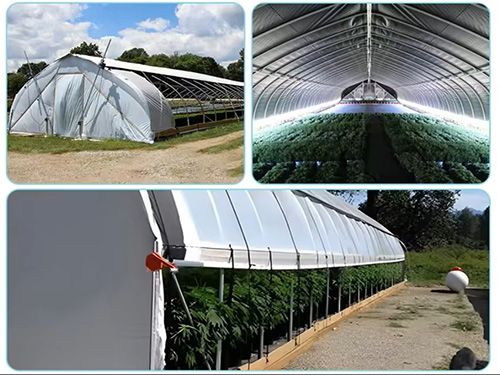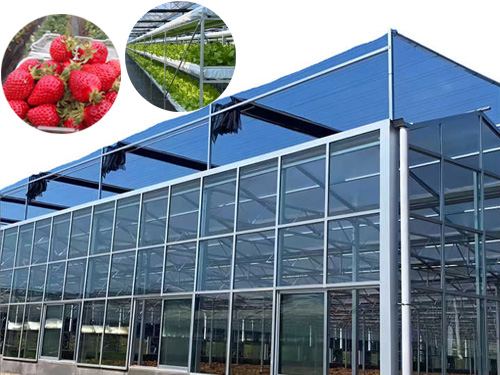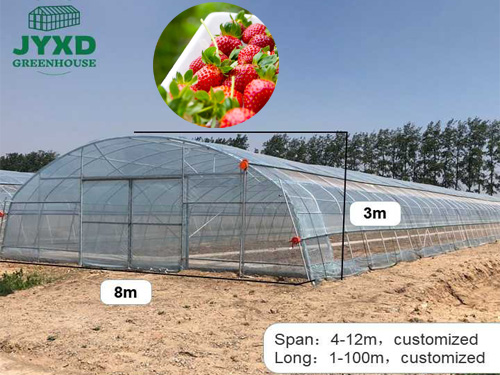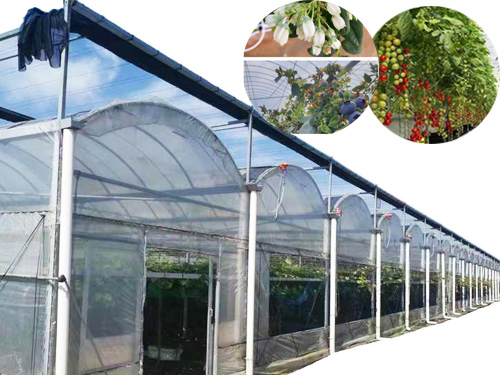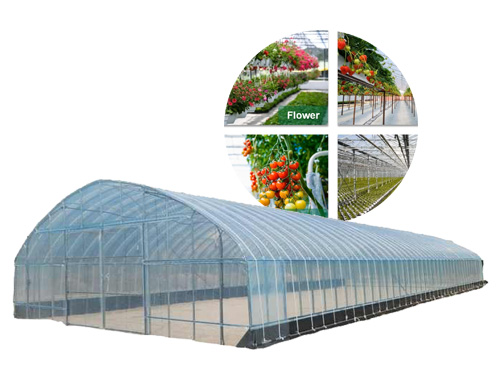NEWS DETAILS
NEWS INFORMATION
Energy-Efficient Greenhouse Materials: How to Reduce Energy Consumption with Eco-Friendly Options
AUTHOR:jyxd-greenhouse DATE:2025-03-21 10:58:05 HITS:80
In an era where sustainability is at the forefront of agricultural practices, reducing energy consumption in greenhouses is becoming a top priority for growers. Greenhouses require significant energy for heating, cooling, and lighting, and the materials used in their construction can have a direct impact on their energy efficiency. By choosing eco-friendly and energy-efficient materials, greenhouse owners can reduce their energy usage, lower operating costs, and create a more sustainable growing environment. This article will explore some of the best energy-efficient greenhouse materials that can help you reduce energy consumption while supporting environmentally friendly practices.
1. Insulating Glazing Materials
The type of glazing material you choose for your greenhouse plays a crucial role in regulating the temperature inside and minimizing the need for artificial heating or cooling. Insulating glazing materials help maintain a stable internal temperature by reducing heat loss in cold weather and preventing excessive heat buildup in hot weather.
Polycarbonate Panels
Polycarbonate panels are one of the most popular energy-efficient glazing materials for greenhouses. These panels come in twin-wall or triple-wall varieties, which provide superior insulation compared to single-pane glass. The air pockets within the multi-wall design act as an insulator, helping to retain heat during colder months while preventing excess heat from entering during the summer. Polycarbonate panels are also UV-resistant, durable, and lightweight, making them an excellent choice for eco-conscious growers.
Polyethylene Film
Polyethylene film is another cost-effective option for greenhouse glazing. Often used in a double-layered setup, polyethylene film provides good insulation while allowing natural light to enter the greenhouse. The air gap between the layers acts as an insulating barrier, reducing heat loss and improving energy efficiency. Polyethylene is also a great choice for regions with colder climates, as it helps maintain a stable internal temperature with minimal energy use.
Glass with Low-Emissivity Coatings
For those who prefer the aesthetic appeal of glass, low-emissivity (Low-E) coated glass can be an energy-efficient option. This type of glass has a special coating that reflects infrared light, helping to retain heat inside the greenhouse while allowing visible light to pass through. Low-E glass is particularly beneficial in areas with cold winters, as it helps keep the greenhouse warm without relying heavily on heating systems.
2. Energy-Efficient Heating Systems
Heating is one of the most significant energy costs for greenhouse operations, especially during colder months. To minimize energy consumption, selecting the right heating system and combining it with energy-efficient materials can make a significant difference.
Radiant Heating
Radiant heating systems, such as underfloor heating or radiant heating pipes, are an energy-efficient option for greenhouses. These systems work by emitting heat directly to the plants and the surrounding environment, rather than heating the air. Radiant heating helps maintain a stable temperature while reducing energy waste, making it a cost-effective choice for growers looking to minimize their energy usage.
Geothermal Heating
Geothermal heating uses the earth’s natural heat to warm the greenhouse. By installing a geothermal heat pump system, growers can take advantage of stable underground temperatures to reduce the need for conventional heating methods. This sustainable energy source is ideal for large-scale greenhouses and can lead to significant long-term energy savings.
3. Efficient Lighting Systems
Greenhouses often require supplemental lighting, particularly during the winter months or in areas with limited natural sunlight. By selecting energy-efficient lighting options, you can reduce electricity consumption and lower overall energy costs.
LED Grow Lights
LED grow lights are highly efficient and energy-saving, making them an ideal choice for greenhouse lighting. Unlike traditional incandescent or fluorescent lights, LED lights consume less energy while providing the right spectrum of light for plant growth. Additionally, LEDs produce less heat, reducing the need for cooling systems. By using LED grow lights, greenhouse owners can significantly cut down on their energy consumption and create a more sustainable growing environment.
Light-Emitting Diode (LED) Panels with Sensors
LED panels that are equipped with light sensors can help optimize lighting in your greenhouse. These sensors automatically adjust the light intensity based on the amount of natural light available, ensuring that plants receive the right amount of light while minimizing energy waste.
4. Thermal Mass Materials for Heat Retention
Thermal mass materials absorb and store heat during the day and release it at night, helping to maintain a stable temperature in the greenhouse. These materials reduce the need for heating systems by naturally regulating the greenhouse’s internal climate. By incorporating thermal mass materials into your greenhouse design, you can reduce your reliance on energy-intensive heating methods.
Concrete and Stone
Concrete floors and stone walls are excellent thermal mass materials for greenhouses. These materials absorb heat during the day and release it during cooler nights, helping to stabilize the internal temperature. Adding concrete or stone to your greenhouse’s design can be an effective way to optimize energy usage, especially in regions with fluctuating temperatures.
Water Barrels and Tanks
Water barrels or tanks placed strategically in your greenhouse can also serve as thermal mass materials. Water has a high thermal capacity, meaning it can store a significant amount of heat and release it gradually. By placing water containers in areas where they receive direct sunlight, you can harness this natural heat storage system to maintain a more consistent temperature inside your greenhouse.
5. Shade Cloth and Reflective Materials
Excessive heat and sunlight can lead to overheating in a greenhouse, especially during summer months. To reduce the need for air conditioning or additional cooling systems, shade cloths and reflective materials can be used to regulate temperature and protect plants from heat stress.
Shade Cloth
Shade cloths are used to reduce the amount of direct sunlight that enters the greenhouse, preventing overheating and lowering cooling costs. By selecting the appropriate shade percentage (from 30% to 90%), you can control the light intensity and temperature inside the greenhouse, creating a more energy-efficient environment for plant growth.
Reflective Materials
Reflective materials, such as Mylar or aluminet, can be used to bounce light back into the greenhouse, optimizing light distribution without increasing heat. These materials help plants receive uniform light exposure while reducing the need for additional lighting systems.
6. Rainwater Harvesting Systems
In addition to using energy-efficient materials for heating and lighting, incorporating a rainwater harvesting system can further reduce your environmental impact. By collecting rainwater from the roof of your greenhouse, you can reduce the need for municipal water supply and reduce your energy usage for irrigation. Rainwater harvesting systems are particularly beneficial in areas where water conservation is a priority.
7. Conclusion
By selecting energy-efficient and eco-friendly materials, greenhouse owners can significantly reduce energy consumption while promoting sustainable practices. Insulating glazing materials like polycarbonate panels and polyethylene film, along with energy-efficient heating systems, lighting solutions, and thermal mass materials, all contribute to creating a more energy-efficient greenhouse environment. Additionally, incorporating shade cloth, reflective materials, and rainwater harvesting systems can further reduce energy consumption and minimize your environmental footprint.
Making the switch to energy-efficient materials not only benefits the environment but also helps to lower operational costs and improve long-term sustainability. Whether you are constructing a new greenhouse or upgrading an existing one, these eco-friendly options provide practical and effective solutions for reducing energy consumption and creating a more efficient, sustainable growing environment. To learn more about energy-efficient greenhouse materials or to explore customized solutions for your greenhouse, feel free to contact us.
Hebei Juyou Xinda Greenhouse Facilities Co.,Ltd.
Copyright © 2024-2025 https://www.jyxd-greenhouse.com. All Rights Reserved Hebei Juyou Xinda Greenhouse Facilities Co.,Ltd.Copyright





 Current Location:
Current Location:


